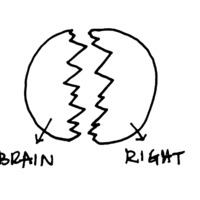-
Title
-
Laundering (Grossly Simplified)
-
Description
-
I input the data-as-given into my right brain, then after converting it via a totally unrelated sign-pattern, I transfer it to my left brain, which I then output as completely recoded numbers and type up on paper. This is what is called laundering. Grossly simplified, of course. The conversion code varies with the Calcutec. This code differs entirely from a random number table in its being diagrammatic. In other words, the way in which right brain and left brain are split (which, needless to say, is a convenient fiction; left and right are never actually divided) holds the key. Drawn, it might look something like [the Figure].Significantly, the way the jagged edges do not precisely match up means that it is impossible to reconvert data back into its original form. Nonetheless, Semiotecs can occasionally decode stolen data by means of a temporary bridge. That is, they holographically reproduce the jagged edges from an analysis of the data-as-retrieved. Sometimes it works, sometimes it doesn't. The more we Calcutecs up our technologies, the more they up their counter-technologies. We safeguard the data, they steal it. Your classic cops-and-robbers routine.
-
Designer
-
Murakami, Haruki
-
Date
-
1991
-
Source
-
Hard-Boiled Wonderland and The End of the World
-
Bibliographic Citation
-
Murakami, Haruki. 1993. Hard-Boiled Wonderland and The End of the World. Translated by Alfred Birnbaum, with the participation of the author. Vintage Books. Pages 32-33.
-
Murakami, Haruki. 1991. Sekai no owari hādo-boirudo wandārando. Shinchosha Ltd. and Kodansha Internartional Ltd.
-
is depiction of attribute
-
English
Circle
-
is composed of
-
English
Circle
-
has attribute
-
English
Zigzag Line
-
English
Solid Line
-
English
Arrow
-
depict things of type
-
English
Sequence or Process
-
English
Typological or Classification
-
Coverage
-
literature
-
mind
 Murakami-HardBoiled.png
Murakami-HardBoiled.png